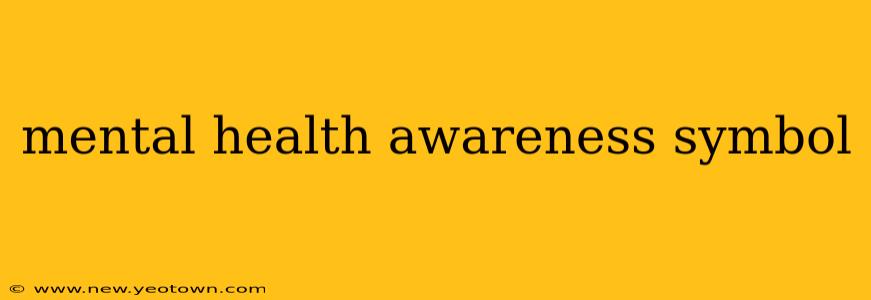For years, the conversation around mental health has been evolving, shifting from hushed whispers to open dialogues. This progress is partly thanks to increased awareness and the symbols that represent it. But what exactly is the mental health awareness symbol, and what does it signify? The answer, surprisingly, isn't as straightforward as one might think. There isn't one single, universally adopted symbol. Instead, different organizations and campaigns use various images to raise awareness, each with its own nuances and meaning. Let's unravel the story behind some of these representations.
What is the most common mental health awareness symbol?
This is a great question, and the answer depends on context. You'll often see a ribbon used, most frequently a yellow ribbon, associated with suicide prevention and mental health awareness in general. However, it's important to note that the color yellow, while widely used, isn't universally standardized for all mental health conditions. Different colors are sometimes used to represent specific illnesses or causes (e.g., green for anxiety, purple for eating disorders). The ribbon, therefore, acts more as a general visual cue indicating support for mental well-being than a specific symbol for any one condition.
What does the yellow ribbon symbolize in mental health?
The yellow ribbon, while not officially designated by a single governing body, has become a powerful visual identifier linked primarily to suicide prevention and mental health awareness more broadly. Its use stems from the broader tradition of ribbons representing various causes, and its bright, optimistic color conveys a sense of hope and support. This association has emerged organically through widespread adoption by various organizations and individuals involved in mental health advocacy. The yellow ribbon is a symbol of solidarity, a visual reminder that we're not alone in facing mental health challenges.
What are some other symbols used for mental health awareness?
Beyond the yellow ribbon, several other symbols represent different aspects of mental health. These can include images like a blooming flower, representing growth and recovery, or a stylized brain, highlighting the organ's importance in mental health. Specific organizations may also create unique logos or designs representing their particular mission, furthering the diverse visual landscape surrounding mental health awareness. The absence of one singular, dominant symbol reflects the multifaceted nature of mental health itself.
Is there an official mental health awareness symbol?
No, there isn't one single, officially recognized mental health awareness symbol. This lack of a standardized symbol, while potentially confusing, underscores the dynamic and evolving nature of the conversation around mental health. The diverse representations reflect the varied experiences, conditions, and needs within the mental health community. While the yellow ribbon holds significant prominence, other visual cues continue to emerge and contribute to the growing awareness surrounding this critical issue.
How can I support mental health awareness?
Supporting mental health awareness extends far beyond simply recognizing a symbol. It involves actively engaging in conversations, educating yourself and others, challenging stigma, and advocating for better access to mental healthcare. Consider these actions:
- Educate yourself: Learn about different mental health conditions, their symptoms, and available resources.
- Share your story (if you're comfortable): Sharing your experiences can help destigmatize mental health challenges.
- Support mental health organizations: Donate or volunteer your time to organizations that promote mental well-being.
- Start conversations: Talk openly and honestly about mental health with friends, family, and colleagues.
The symbols of mental health awareness serve as important visual reminders, but it's the actions we take to support individuals and advocate for change that truly make a difference. The journey towards understanding and acceptance is ongoing, and every step, big or small, contributes to a healthier and more supportive community.

